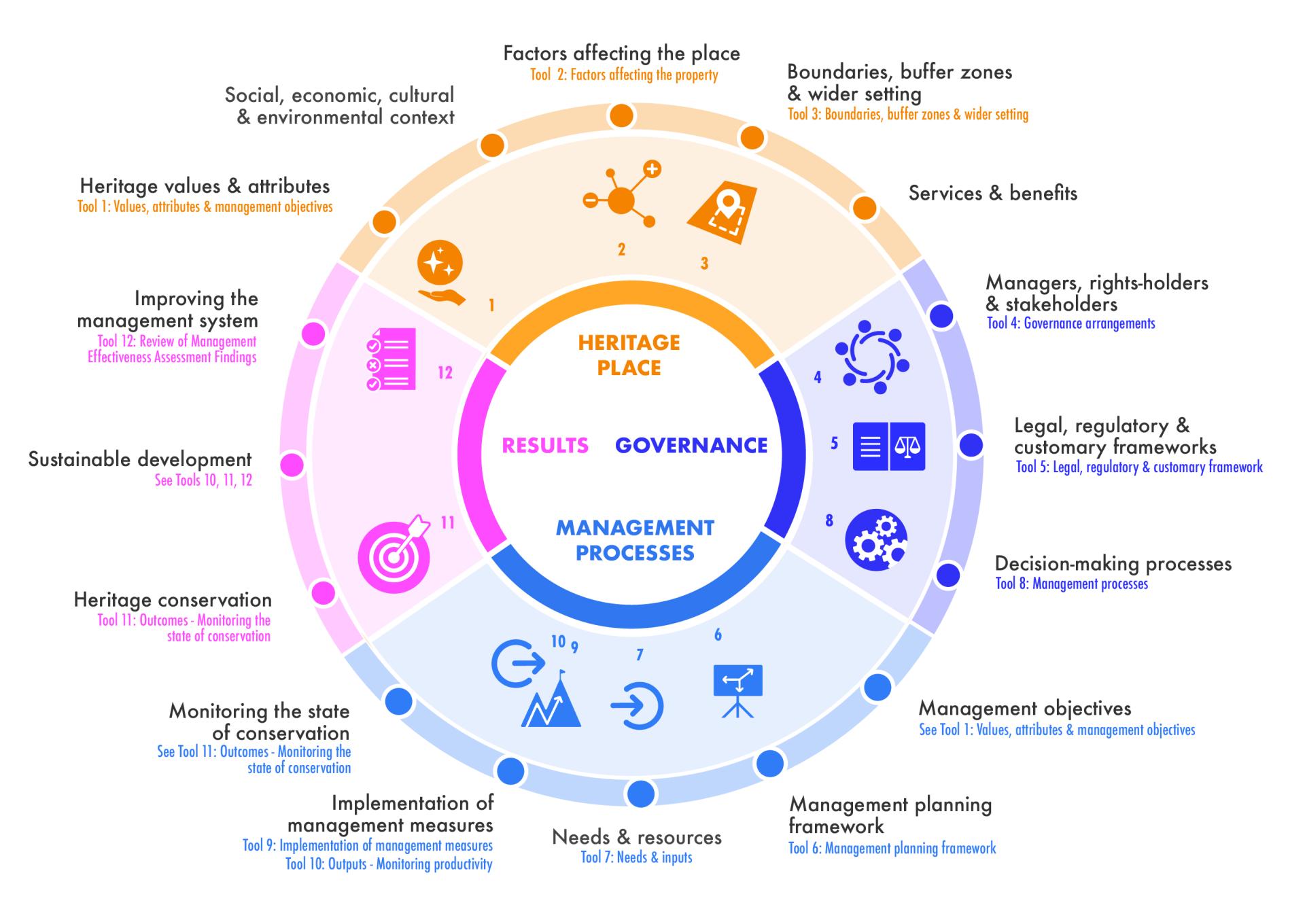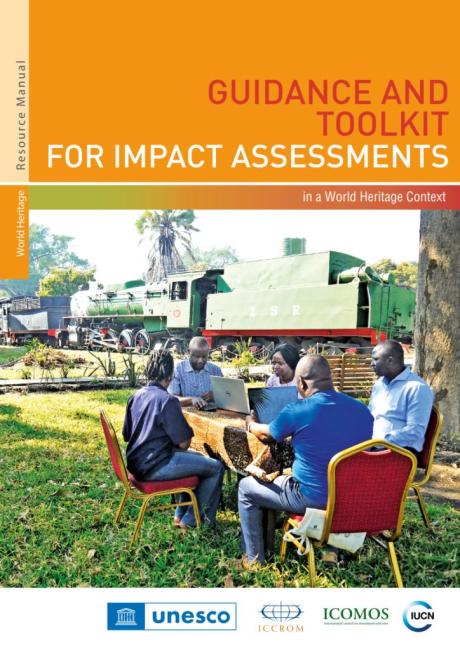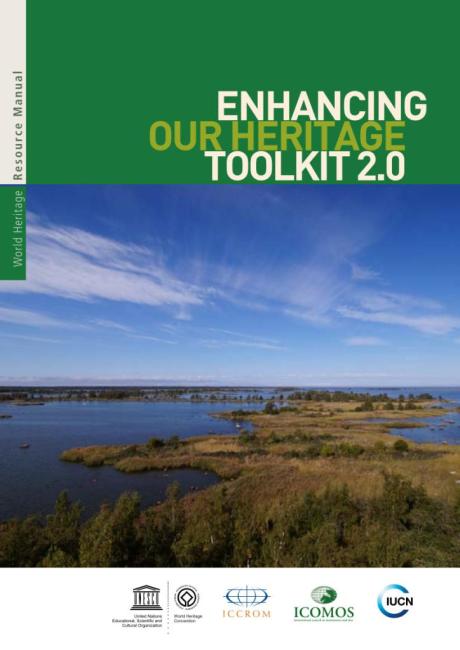Enhancing Our Heritage Toolkit 2.0: assessing management effectiveness of World Heritage Properties and other heritage places
The Enhancing Our Heritage Toolkit 2.0 (EOH 2.0) offers a detailed management effectiveness methodology which is suitable to the specific needs of World Heritage properties but can be applied to all other natural and cultural heritage places. It contains twelve tools that can be used separately or collectively to evaluate the effectiveness of a management system. Each tool has a specific purpose and includes guidance to help managers engage in full and open discussion about the most critical elements of the management system. To facilitate their use, the tools are accompanied by worksheets and prompt questions to help compile information in a systematic way and to help managers identify opportunities for improvement and necessary actions. Together, the tools offer an iterative methodology that will enable managers to identify what is working well and what can be done better.
EOH 2.0 has three important qualities.
- It is the only management effectiveness methodology specifically tailored to all types of heritage places. It has been developed to suit cultural and natural heritage places and, while there is a focus on World Heritage properties, it can be applied to all heritage places, regardless of designation(s) at international, national and/or local levels.
- It is a fully self-assessed methodology. EOH 2.0 is designed to be used directly by managers – generally without external support, validation or information sharing, unlike some of the other methodologies, which are externally led (such as the IUCN World Heritage Outlook Assessment), or need a level of external validation (such as the IUCN Green List), or share information with external actors (such as the Periodic Reporting exercise).
- It is the most detailed and comprehensive management assessment methodology. EOH 2.0 contains a set of 12 practical tools tailored to make in-depth assessments of critical elements of the management system for a
World Heritage property
A cultural, natural or mixed heritage place inscribed on the World Heritage List and therefore considered to be of OUV for humanity. The responsibility for nominating a property to the World Heritage List falls upon the State(s) Party(ies) where it is located. The World Heritage Committee decides whether a property should be inscribed on the World Heritage List, taking into account the technical recommendations of the Advisory Bodies following rigorous evaluation processes.
When used as a general term, World Heritage refers to all the natural, cultural and mixed properties inscribed on the World Heritage List. or other heritage place. It uses a participatory process to better understand underlying reasons why certain elements of the management system may not be working as effectively as they could be.
Assessment findings should lead to improvements in the management system. The long-term goal is to repeat the assessment at regular intervals to allow managers to track progress over time. A one-off assessment, while beneficial, is only a diagnosis at a given moment. Assessments are only worth the time and energy needed to undertake them if they lead to improvements in management measures to identified gaps and challenges.
The results of the follow-up actions and recommendations defined to address the gaps and challenges throughout the assessment can only be measured after implementation, which requires time. This is why management effectiveness assessments should be embedded in the management cycle and linked with scheduled timings for revisions of the management plan. If there are a great array of gaps and challenges, it will not be possible to address them all in a single management cycle, and longer periods of time will be required. This reinforces the need to repeat the assessments at regular intervals in order to evaluate how management effectiveness is progressing.
Therefore, all assessments must conclude with the development of an action plan or strategy to prioritize and implement findings and follow-up actions. Some of these actions can be included in the next management plan, others may require dedicated efforts, for example, if related to changes in the boundaries or in the legal framework.

Figure 6.1 The twelve tools from the Enhancing our Heritage All inherited assets which people value for reasons beyond mere utility. Heritage is a broad concept and includes shared legacies from the natural environment, the creations of humans and the creations and interactions between humans and nature. It encompasses built, terrestrial, freshwater and marine environments, landscapes and seascapes, biodiversity, geodiversity, collections, cultural practices, knowledge, living experiences, etc. Toolkit 2.0 can be used separately or collectively to evaluate the effectiveness of the management system. The tools can be used to analyse the most critical elements of the management system. The social, economic, cultural and environmental context together with services and benefits of the heritage place are overarching aspects which can be drawn out by using the tools collectively.
Hockings, M., Leverington, F. and Cook, C. (2015) ‘Protected area management effectiveness’, in Worboys, G.L. ,Lockwood, M., Kothari, A., Feary, S., and Pulsford, I. (eds) Protected Area Governance and Management, pp. 889–928. Canberra (Australia), ANU Press.
UNESCO, ICCROM, ICOMOS, IUCN (2023). Tool 12 Review of Management Effectiveness Assessment Findings in Enhancing Our
Heritage
All inherited assets which people value for reasons beyond mere utility. Heritage is a broad concept and includes shared legacies from the natural environment, the creations of humans and the creations and interactions between humans and nature. It encompasses built, terrestrial, freshwater and marine environments, landscapes and seascapes, biodiversity, geodiversity, collections, cultural practices, knowledge, living experiences, etc.
Toolkit 2.0, Paris, UNESCO.



